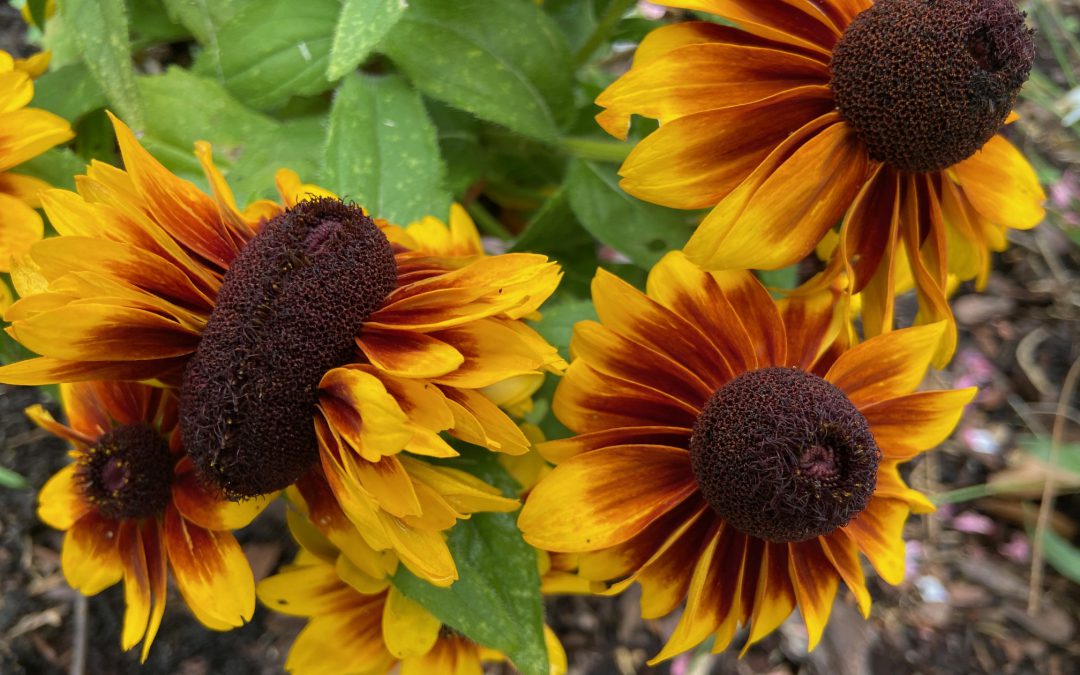
by Mary Salinas | Jul 16, 2020
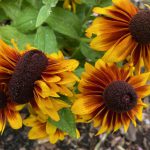
Fasciation of Rudbeckia hirta ‘Toto Rustic’. Photo credit: Mary Salinas, UF IFAS Extension.
You never know what surprises are looming in your flower gardens.
This Rudbeckia in the photo to the left sported one bloom that was so different from all the others. The disk or central portion of the inflorescence was elongated and curved back on itself and created a contorted, crazy looking bloom. And then there was a yellow squash in my garden that had a leaf growing down the length of the squash. What caused these things to happen?
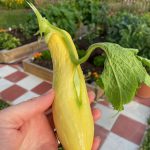
Fasciation in yellow summer squash. Photo credit: Mary Salinas, UF IFAS Extension.
This is a mutation, often genetic, but also could be caused by outside influences such as pathogens, injuries, or chemicals. Plant hormones may also play a role in this phenomenon. This mutation expresses itself as a malformation or cresting at the tip or growing point of the plant, also known as the meristem. We call this fasciation and it begins when the cells at a growing point of a plant start dividing in an uneven or asymmetrical fashion instead of the normal symmetrical pattern.
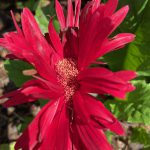
A gerbera daisy affected by fasciation. Photo credit: Mary Salinas, UF IFAS Extension.
There are some plants we embrace for their fasciation. A common one is cockscomb celosia that is prized for its showy crested inflorescence. Cacti and succulents more commonly exhibit fasciation and we can see it in some of the crested cacti.
Take a close look at what is happening in your garden and landscape. Plant biology is fascinating!
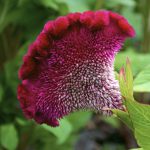
Cockscomb Celosia inflorescence. Photo credit: Lee Terilla 2008, some rights reserved.
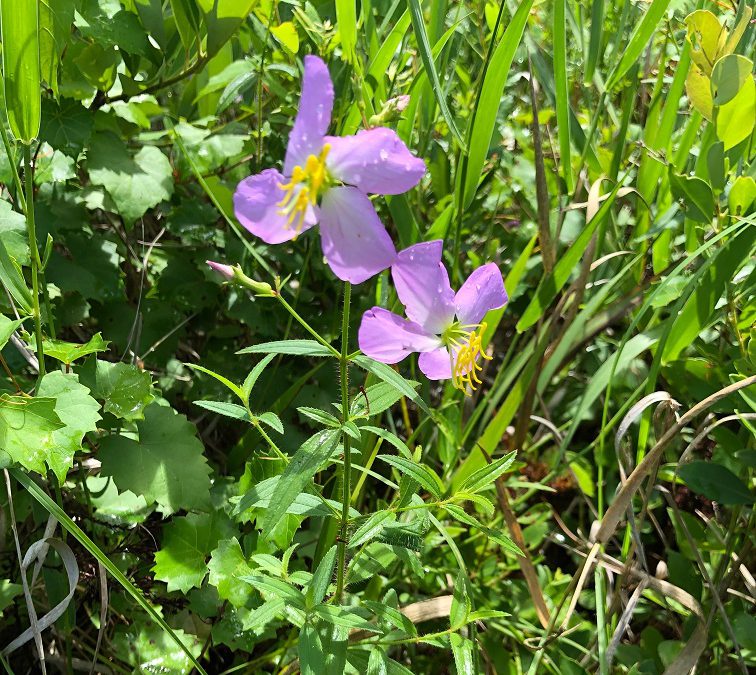
by Stephen Greer | Jul 16, 2020
By: Stephen Greer, CED Santa Rosa County
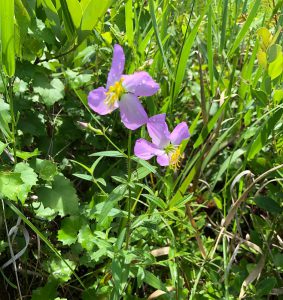
Rhexia marianna Photo credit: Stephen Greer, University of Florid IFAS
There is a lot to be said about early morning or late afternoon walks along a woodland trail in Northwest Florida. With so much to see, hear and smell there is never enough time to take it all in. I would suggest slowing down and look for the many colorful and interesting plants these native plant communities have to offer.
I had the great fortune to meet with a group of plant explores lead by Angus Gholson, botanist and conservationist with a passion to share his knowledge in Washington County many years ago for a 5-hour hiking adventure. We hiked an exceptional longleaf pine forest with immense flora on the forest floor. It was all but impossible to see everything.
We searched for unique and common plants in the Sandhills and Clayhills in the central and northern areas of Washington County. Here are just a few of the plants we saw along our hike and some detail about them.
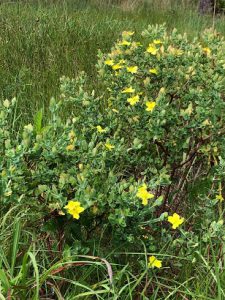
St. Peter’s-wort. Photo create: Stephen Greer University of Florida IFAS
St. Peter’s-wort, Hypericum tetapetalum is a wonderful Hypericum of the many we have in NW Florida. With its ability to repeat bloom petite yellow flowers from March to November, we often get the chance to revisit these trails at a later date for another chance to enjoy them. Like many repeat blooming natives, there will be weeks of rest periods with no bloom. This shrub will grow to three feet tall allowing the flowers to peak out over other plants in the pine flatwoods.
Shiny Lyonia, Lyonia lucida is another exceptional shrub with many uses. This evergreen can grow in low damp areas or with irrigation in landscapes to 10 to 12 feet tall. When found in pine forest areas they range from 3 – 6 feet tall. This Lyonia produces an attractive small bell-shaped red flower spread across a stem of last years growth similar to blueberry. Flowering can occur between November and June.
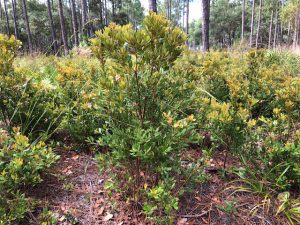
Lyonia lucida. Photo credit: Stephen Greer, University of Florid IFAS
Pale Meadow Beauty, Rhexia Marianna brings a soft pink bloom to the pine forest, grass prairies and edge of full sun to part-shade wetlands. With the ability to grow in diverse landscapes in Northwest Florida it can just about show up anywhere, bloom a few weeks and melt back into the natural setting. Seeding is best completed in the fall and consistent moisture is needed for bloom to occur.
All three of the plants in this article can be found at native plant nurseries. Call the nursery well ahead of time to make sure they either have it or can order it for you. Enjoy the outdoors and adventure it has to offer.
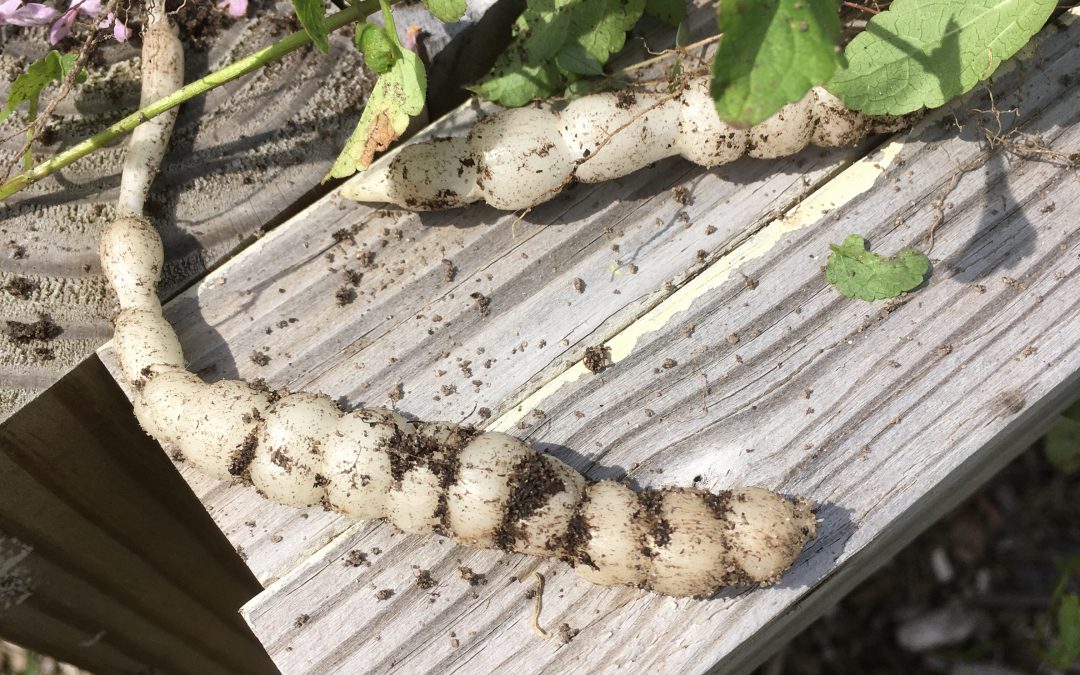
by Julie McConnell | Jun 11, 2020
Why are the plants we are trying not to grow so hard to kill? Weeds can be quite frustrating to home gardeners as they struggle to get them under control. There are a few things you can do to help make your efforts more successful.
Identify the weed. It might seem like it doesn’t matter what the plant is if you know you want to get rid of it, but a big part of your strategy should be figuring out why that plant is being so difficult. Below are the reasons why weed identification is so critical in your fight to control it.
- Which plant are you favoring with your maintenance routine? All plants have similar basic needs: water, sunlight, nutrients, and a space to grow, but some perform better with varying amounts of each of these inputs. Sometimes we can influence these factors in a way that favors one plant over another. The best example is how we irrigate our landscape. If you plant drought tolerant shrubs, such as Indian Hawthorne, which can survive with little to no irrigation after establishment, and then continue to water 2-3 times a week, is it any wonder that you get water loving weeds such as dollarweed, torpedograss, or sedge? Only apply inputs that support your desirable plants and nothing more.
- Recognize the weed type. There are three main types of weeds we typically encounter: broadleaf, grass, or sedge. Some herbicides are broad-spectrum, which means they kill any type of plant, while others are selective. Selective herbicides generally target either broadleaf, grass or sedge weeds and have minimal impact on the other types. This can be very important information to have if you are shopping for an herbicide.
- Understand the life cycle. Herbaceous plants fall into three main life cycle categories: annual, perennial, or biennial. Annuals and biennials tend to reproduce primarily from seed. The annual plant completes its entire life cycle in one season or year and a biennial takes two years. When targeting these two, your goal is to get rid of the plant before it flowers and sets seed to reduce future crops. If you miss that window and the weeds go to seed, plan to use a pre-emergent herbicide prior to their next scheduled germination date (usually the next season). Perennials live for more than 2 years and tend to be tough to manage. They may reproduce by seed but many also multiply by vegetative means. To put this simply, they store everything they need in tiny pieces of the plant and if left in place, it will generate more plants. So, that little tiny root fragment from dollar weed you didn’t pull up – yep, it’ll grow a whole new one in its place!
For more information on weeds and weed control in lawns and landscapes, contact your local UF/IFAS County Extension Office!
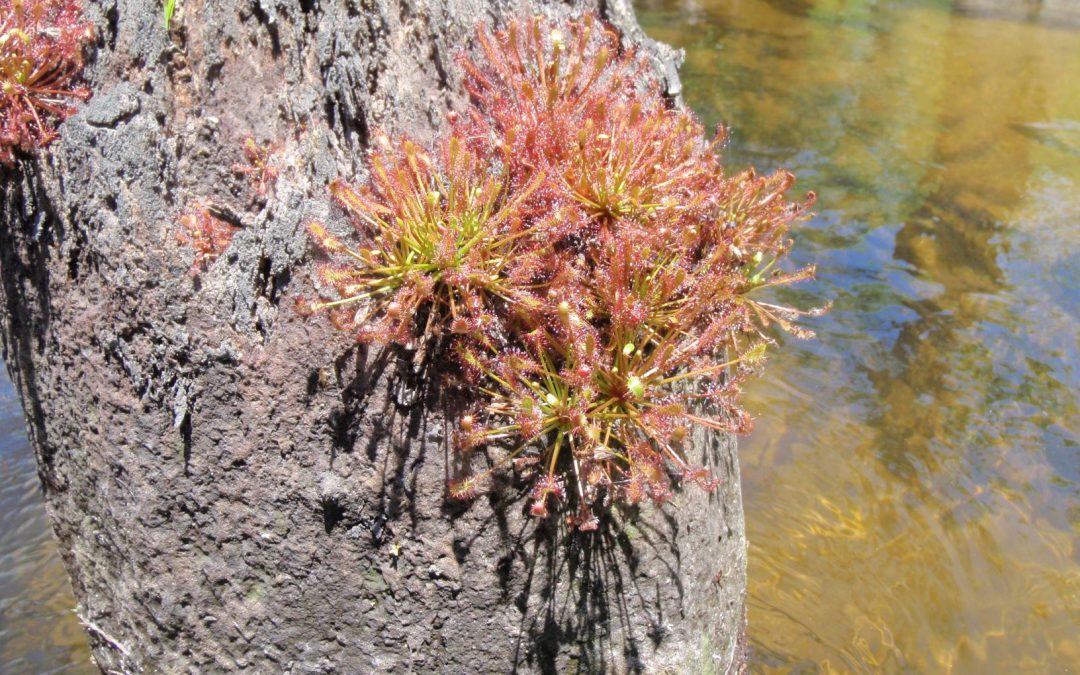
by Carrie Stevenson | Jun 4, 2020
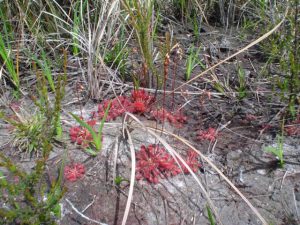
Sundews, tiny carnivorous plants found in pitcher plant bogs, use an enzyme dissolve insect proteins. Native Americans recognized this property and used the plant for skin maladies. Photo credit: Carrie Stevenson, UF IFAS Extension
There are few words better than “pure delight” to describe the face of someone who sees and appreciates a sundew for the first time. Maybe it is their size—often no bigger around than a quarter—or the miniature pinwheel shape, but sundews could easily fit into a fable about garden gnomes or fairies in the woods. These tiny plants hide in plant sight–so small and flush to the ground that you likely won’t see them unless specifically looking for them. But, once you are looking in the right conditions, you will probably see them everywhere.
Sundews (Drosera spp.) are small carnivorous plants found in the same bogs as pitcher plants. They thrive in moist, mucky soil and full sun. They are also carnivorous for the same reasons pitcher plants are—their wet, acidic habitats possess few soil nutrients, so they use insects instead.
Sundews utilize a different method for trapping insects—their flat, radiating structure has wider lobes on the ends, which are covered with hairlike tentacles. These hairs secrete droplets of sticky sap visible at the tip of each hair. Small insects are attracted to the dewlike sap and get stuck. The hairs curl around the insect like a slow Venus flytrap, and natural enzymes to break down the bug.
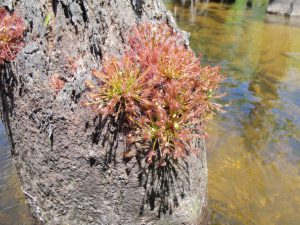
A healthy sundew plant growing just above the water level at Boiling Creek in Santa Rosa County. Photo credit: Larry Burner, Florida Master Naturalist
There are almost 200 species of sundews, not all with the flat growth pattern. The threadleaf sundew has an upright structure, while others may grow in a spherical shape at the water’s edge. While paddling Boiling Creek on Eglin Air Force Base property a few years ago, our group saw dozens of sundews growing on the trunks of cypress and tupelo trees at eye-level from our kayaks. They were about 4-6” in diameter, much larger than the 1” ones we typically see in the bogs.
Tarkiln State Park, Weeks Bay National Estuarine Research Reserve, or any place you find pitcher plants are a great place to find sundews. You may have to get on your knees to see them, and move the grasses aside. Bring a hand lens to magnify the delicate details of the droplets of sap perched at the tip of tiny hairs.
Even the famous naturalist Charles Darwin was enthralled with sundews, conducting experiments and writing volumes about them. In an 1860 letter to his geologist friend Charles Lyell, Darwin stated that, “at the present moment, I care more about Drosera than the origin of all the species in the world.” If you, too, are fascinated with carnivorous plants, check out these resources from UF IFAS Extension and the Botanical Society of America.
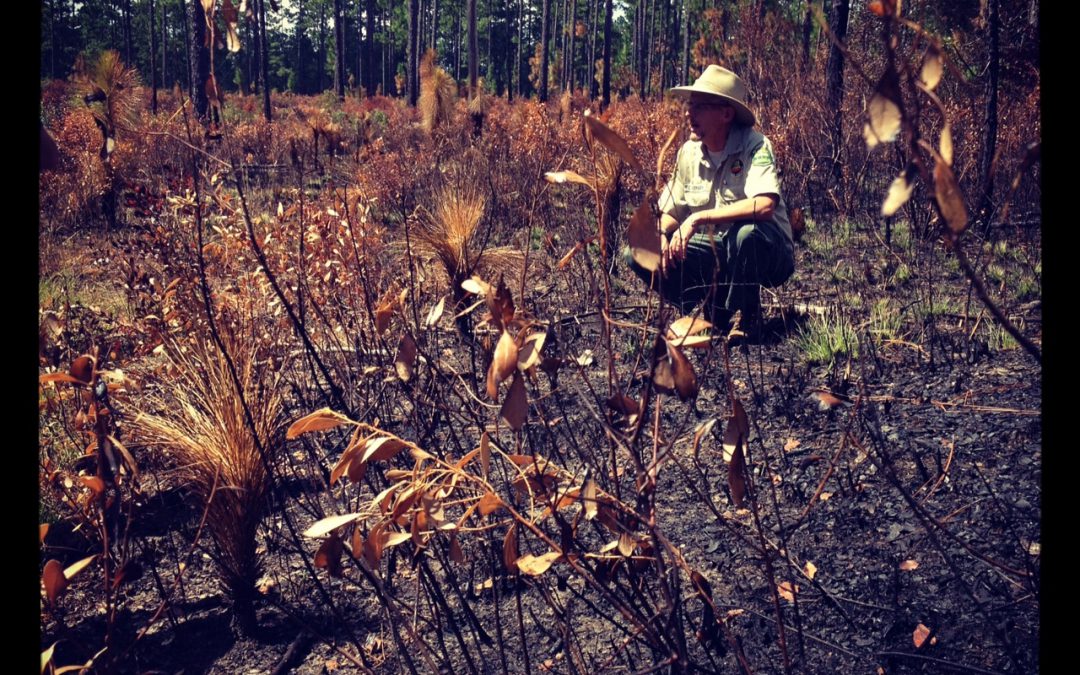
by Carrie Stevenson | Apr 8, 2020
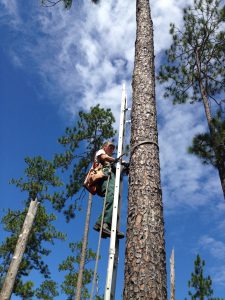
A biologist at Blackwater State Forest monitors endangered woodpecker habitat in a longleaf pine. Photo credit: Carrie Stevenson, UF IFAS Extension
In the Southeastern United States, our forests were once primarily longleaf pine-dominated ecoystems. Frequent summer thunderstorms and their accompanying lightning strikes would routinely set a portion of the forest afire. With plenty of space to move, wild animals relocated to safer portions of the forest or hunkered down in deep, winding gopher tortoise burrows underground. The longleaf pine’s life cycle has co-evolved with fire in such a way that its young growth stage is resistant to fire, and its success as a species requires fire to open up the canopy.
As human populations grew larger in the South, much of that forest land was harvested for timber, pitch, and turpentine, then cleared for agriculture and urban development. The American Southeast now has only 5% of that original longleaf pine forest. Thankfully, continued efforts led by organizations like the Longleaf Alliance and The Nature Conservancy have reminded folks of the species’ importance, and led to conservation and restoration efforts.
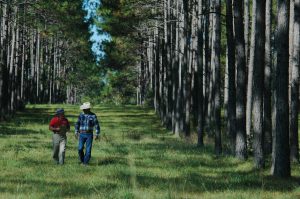
University of Florida Extension Agent surveys a planted forest with a producer in Washington County. UF/IFAS Photo: Josh Wickham.
Now, we have a newer mix of forest cover, with specimen trees preserved in parks and yards. In addition, we also have sustainable tree farms. You may have passed a wooded area where you noticed pine trees (mostly loblolly and slash in the south) were in perfect rows—these are being farmed, planted in rows just like any other crops. While they will be harvested eventually, during their lifetimes these trees fulfill all the roles we appreciate in wild forests–animal habitat, oxygen production, carbon dioxide uptake, and cooling via transpiration. The other positive of sustainable forestry is that almost as soon as they’re cut, they’re replaced. Trees are grown in a stepwise fashion to ensure there is always an available harvest. Multiple generations are grown at once to ensure there is rarely a truly bare spot in the landscape.
With 17 million acres in production, forestry makes up the largest agricultural commodity in Florida. When managing, planting, and harvesting trees, modern foresters take tree physiology, invasive species, disease outbreaks, and genetics into serious consideration. These professionals help produce necessary items for life; wood for construction, furniture, books, and the all-important toilet paper, which has emerged as a bartering item in the time of COVID-19. For more information on forestry in Florida, visit the University of Florida’s School of Forest Resources and Conservation.
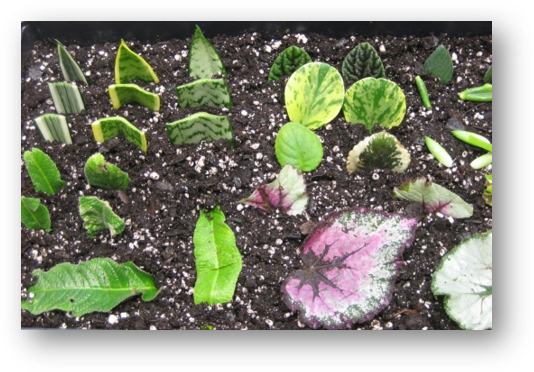
by Matt Lollar | Mar 20, 2020
It’s always fun to add new plant to the landscape. And it’s even more fun to propagate your own plant material. The question is, what plant propagation method is best? The answer depends on a number of factors such as:
- How much time and money is available?
- Is a uniform crop desired or is trait variation preferred?
- What is the plant species being propagated?
Plants can be propagated either by seed (sexual propagation) or by segments of vegetative material (asexual propagation). Sexual propagation takes far less time and effort because new plants are being started from the seeds (offspring) of parent plants. This type of propagation promotes genetic diversity because offspring may not have the exact characteristics of the parent plants. Sexual propagation increases the possibility of hybrid vigor, which is the improved quality of plant material to that of parent plants. Asexual propagation usually takes more time, but generally ensures that propagated plants will maintain the same characteristics as the parent plant. For some species it may be the only way to pass on desired traits to subsequent generations and it may be the only way to propagate certain species. A plant produced vegetatively can become larger than a plant produced by see in the same amount of time.
Tips for Successful Sexual Propagation
- Seed Collection – Seeds should be collected when fruit is ripe, just before they fall to the ground. In general, seeds should be cleaned, dried, and stored at 40 degrees Fahrenheit (in a refrigerator). However, palm seeds should be planted immediately after harvesting and cleaning.
- Seed Dormancy – Some seeds have thick seed coats the inhibit germination. Some seeds need to be scarified (breaking of the seed coat) and/or stratified (stored in a specific environment) in order to germinate.
- Seed Sowing – Seeds can be germinated in flats or other suitable containers in a seed starting media. Seeds should be planted at a depth of two to three times their diameter, but no deeper than 3 inches. Cycad seeds should be planted just below the medium surface.
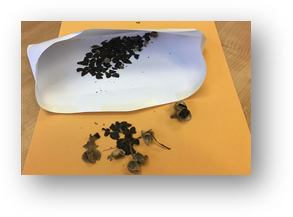
Seeds stored in an envelope. Photo Credit: University of Florida/IFAS
Tips for Successful Asexual Propagation – In general, asexual propagation is the propagation of plant material from cuttings of stems, leaves, and/or roots.
- Rooting Hormones – Increase rooting percentage, hasten root initiation, increase the number of roots per cutting, and increase root uniformity. Auxin based rooting hormones (Indolebutyric acid (IBA) and Naphthalenacetic acid (NAA)) are available in dry or liquid forms. It is important to use the correct concentration for the particular plant species because over application can cause damage to cutting base.
- Sticking Cuttings – Cuttings should be stuck in the medium only deep enough to support the cuttings and hold them upright (1/2″ to 1″ deep).
- Post-Rooting Care – Fertilization should be applied as soon as roots emerge from the cuttings. However, overfetilization can increase soluble salts and burn roots.
Examples of Asexual Propagation
- Softwood Cuttings – Taken from woody plants usually three to four weeks after a new flush of growth. Commonly propagated species using this method include: crape myrtle; magnolia; oleander; azalea; jasmine; and boxwood.
- Semihardwood Cuttings – Similar to softwood cuttings, but the lower portion of the cutting has become lignified (woody). Usually taken from new shoots six to nine weeks after a flush of growth. Commonly propagated species using this method include: camellia; pittosporum; junipers; and some hollies.
- Hardwood Cuttings – Taken from the previous season’s growth, just before or during the dormant period. Commonly propagated species using this method include narrow-leaved evergreens and deciduous species during the dormant season after leaves have dropped.
- Leaf Cuttings – Comprised of only the leaf blade or the leaf blade and petiole (leaf stalk). Cuttings are stuck upright in the propagation medium with the basal end (petiole end) of the leaf inserted into the propagation medium. Commonly propagated species using this method include begonias and peperomias.
- Root Cuttings – Taken in late winter or early spring from two to three-year-old plant material. Plants propagated by root cuttings may not reproduce true to type if they are budded or grafted. Commonly propagated species using this method include: plumbago; bayberry; oakleaf hydrangea; and yucca.

Plants being propagated by leaf cuttings. Photo Credit: University of Florida/IFAS
This article provides only a brief overview of propagation methods and techniques. For more information on plant propagation please visit University of Florida Plant Propagation Glossary or Plant Propagation Techniques for the Florida Gardener. Please be advised that some plant material is patented and it is illegal to propagate patented material without written authorization or licensing of the patent holder. If it is patented, a notation of patent number will be on the tag.


















